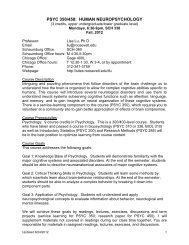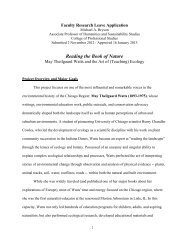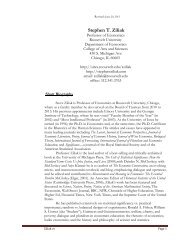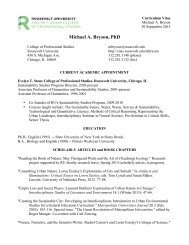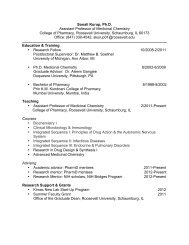Mothering Violence: Ferocious Female Resistance in Toni ...
Mothering Violence: Ferocious Female Resistance in Toni ...
Mothering Violence: Ferocious Female Resistance in Toni ...
Create successful ePaper yourself
Turn your PDF publications into a flip-book with our unique Google optimized e-Paper software.
fall 2011 / black women, gender, and families 33<br />
me peer<strong>in</strong>g around my mother’s dress hop<strong>in</strong>g for a hand that is only for her<br />
little boy. . . . Both times are full of danger and I am expel” (Morrison 2008,<br />
135–37). Worried that she aga<strong>in</strong> will be replaced or excluded, she cannot see<br />
that her lover could love more than one person: “I worry as the boy steps<br />
closer to you . . . As if he is your future. Not me” (ibid., 136). Assum<strong>in</strong>g the<br />
boy also wants her absence, Florens narrates her understand<strong>in</strong>g of him: “He<br />
is silent but the hate <strong>in</strong> his eyes is loud. He wants my leav<strong>in</strong>g. This cannot<br />
happen. I feel the clutch <strong>in</strong>side. This expel can never happen aga<strong>in</strong>” (ibid.,<br />
137). Eventually, Florens attacks the child and shares, “And yes I do hear the<br />
shoulder crack but the sound is small. . . . He screams screams then fa<strong>in</strong>ts”<br />
(ibid., 139–40). The lover reappears at this moment, hav<strong>in</strong>g seen the attack,<br />
and is outraged and angered, ironically reject<strong>in</strong>g Florens, not because he<br />
favors the boy but because he has seen the violence <strong>in</strong>side her, bred and fostered<br />
with<strong>in</strong> slavery and that system’s forcible abandonment by her mother.<br />
While Florens is not able to use violence to get what she wants (her lover), it<br />
is still a rebellious action taken aga<strong>in</strong>st her circumstances. Florens’s violent<br />
attack on the child—and then moments later on her lover—only makes<br />
sense when readers understand her m<strong>in</strong>dset as the daughter sent away by<br />
her mother. Sent away by both her mother and lover, Florens cannot make<br />
sense of the past to create a new life, even <strong>in</strong> freedom. Nonetheless, <strong>in</strong> this<br />
desperate act of violence, Florens rebels aga<strong>in</strong>st the limitations of societal<br />
behavior, tak<strong>in</strong>g action and refus<strong>in</strong>g to accept abandonment yet aga<strong>in</strong>.<br />
The tragedy, of course, is that Florens’s mother was try<strong>in</strong>g to save her<br />
daughter (and likewise her lover was simply be<strong>in</strong>g k<strong>in</strong>d to an abandoned boy),<br />
but, without that crucial piece of <strong>in</strong>formation from her enslaved mother,<br />
Florens does not learn to navigate relationships or learn to trust—and so the<br />
<strong>in</strong>nocent and self-martyr<strong>in</strong>g act of rescue from the mother becomes also an<br />
act of violence, sett<strong>in</strong>g <strong>in</strong> motion her daughter’s future brutality and ultimate<br />
self-destruction.<br />
Similarly, <strong>in</strong> Sula, readers see aga<strong>in</strong> how emotional trauma via mother<br />
violence can affect the development of social empathy and compassion,<br />
thereby creat<strong>in</strong>g subsequent generations of violent females. The pa<strong>in</strong> Sula<br />
feels upon discover<strong>in</strong>g her mother’s op<strong>in</strong>ion of her damages the young girl’s<br />
self-concept, prepar<strong>in</strong>g Sula to become a violent and distant teenager and<br />
adult. Sula’s first realization of her mother’s apathy to her segues <strong>in</strong>to a scene<br />
of accidental violence toward another child and later <strong>in</strong>to a coldness toward<br />
death <strong>in</strong> general. After Sula hears her mother, Hannah, expla<strong>in</strong> that, while she<br />
had maternal feel<strong>in</strong>gs for Sula, she did not like her, Sula feels “bewilderment<br />
. . . [and] a st<strong>in</strong>g <strong>in</strong> her eye” (Morrison 1982, 57). Interest<strong>in</strong>gly, Hannah, asks



